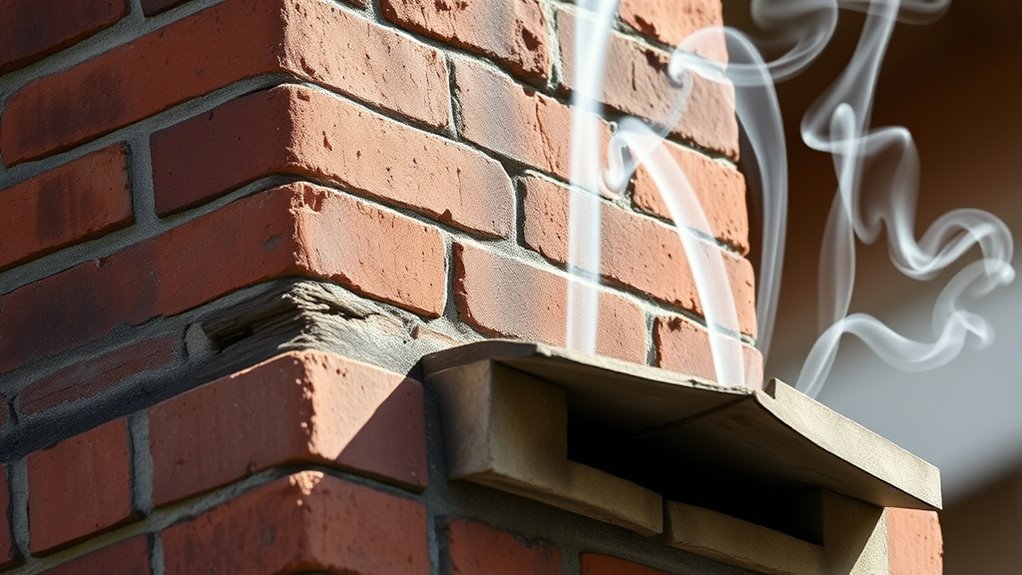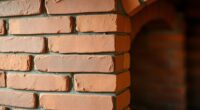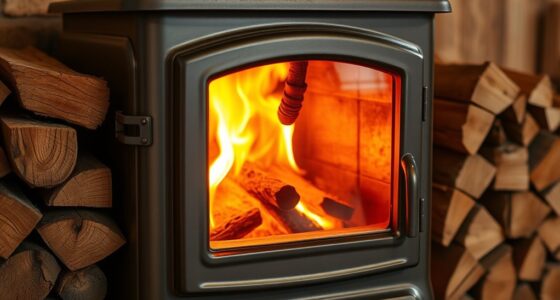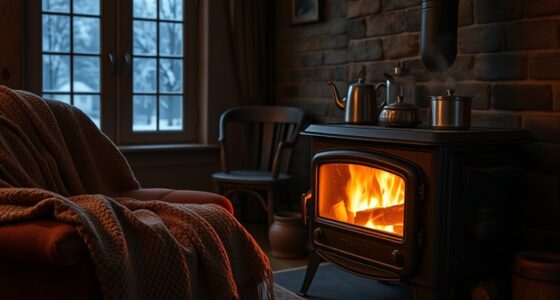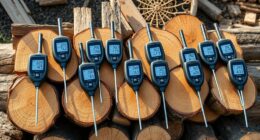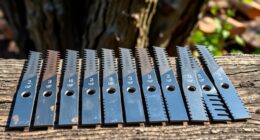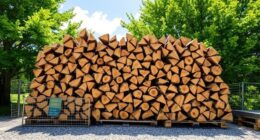Chimney draft problems often happen due to blockages, weather changes, or poor design, which restrict airflow and cause smoke to linger or back up. To fix these issues, check for obstructions like creosote or debris, ensure your chimney has proper height and ventilation, and try opening nearby windows to increase pressure. Regular cleaning and maintenance can prevent many problems, but if issues persist, learning more about solutions can help you keep your fireplace safe and efficient.
Key Takeaways
- Inspect and remove obstructions like creosote buildup, debris, or bird nests in the chimney.
- Ensure proper chimney height and add a cap to improve airflow and prevent downdrafts.
- Increase indoor air pressure by opening windows or doors nearby to boost draft strength.
- Use draft regulators or chimney balloons to stabilize airflow if drafts are inconsistent.
- Seek professional inspection if draft issues persist despite troubleshooting, for safety and thorough diagnosis.
Common Causes of Weak or Inconsistent Chimney Drafts
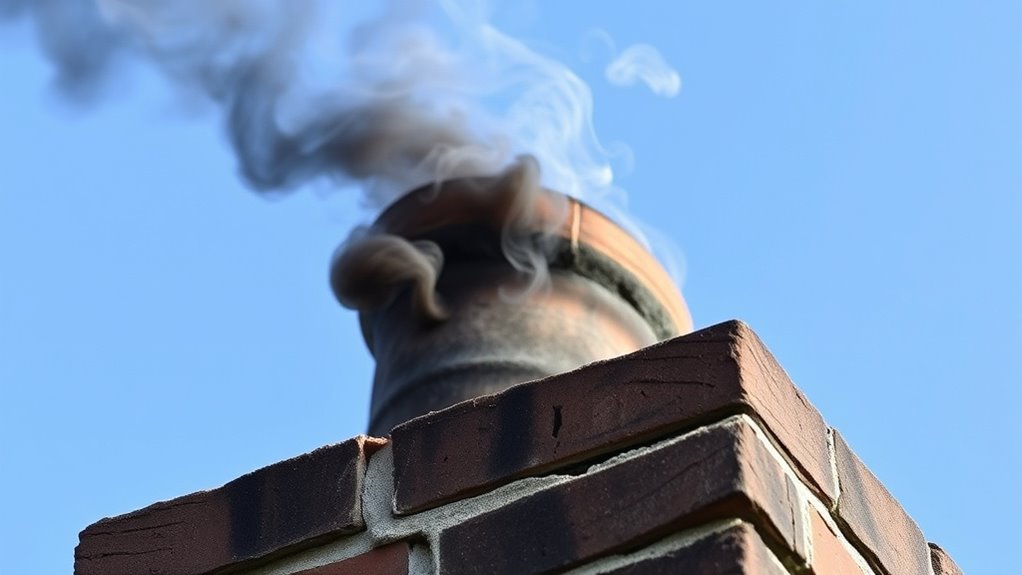
Weak or inconsistent chimney drafts often stem from basic issues with venting or airflow. One common cause is ventilation issues, such as blocked or restricted chimney caps, which can trap air and reduce airflow. Additionally, weather influence plays a significant role; high winds or cold, damp conditions can disrupt the natural flow of air up your chimney. When the outside air pressure is high, it can push against the chimney, preventing proper draft formation. Poorly designed or clogged flues also hinder proper venting, leading to weak drafts. Even nearby structures or trees can influence airflow, especially during storms or gusty weather. Addressing these basic ventilation and weather-related factors is vital for restoring a steady, reliable chimney draft. Proper maintenance and understanding of chimney design principles can help prevent these issues from recurring. Incorporating proper ventilation techniques ensures optimal airflow and enhances draft performance under varying weather conditions. Recognizing the importance of airflow dynamics can further assist in troubleshooting and improving chimney function. Regular inspections and adjustments based on environmental factors can also significantly improve draft consistency, especially when considering how climate variations impact airflow.
How to Diagnose Draft Issues in Your Chimney
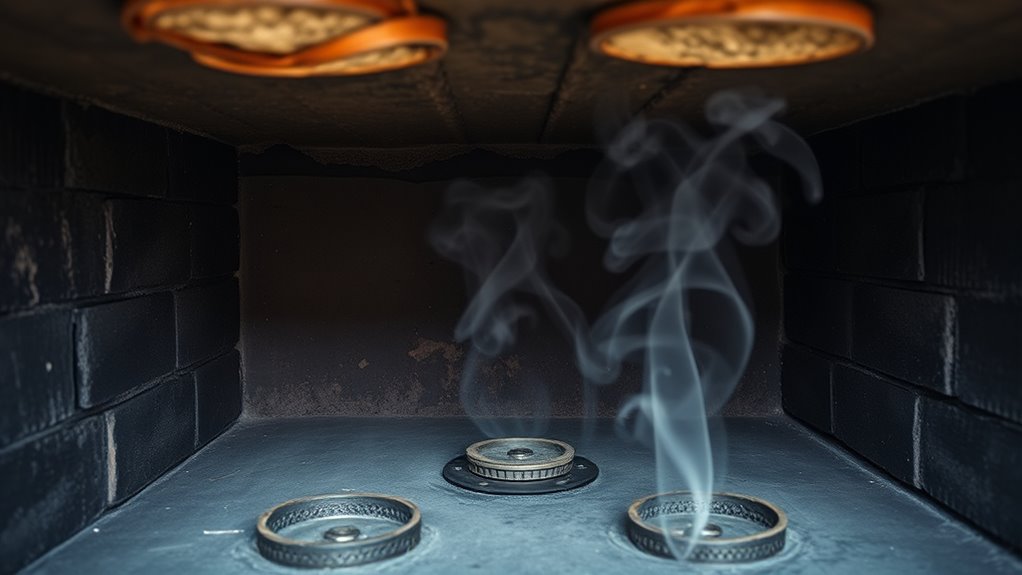
To effectively diagnose draft issues in your chimney, start by performing simple visual and physical checks to identify potential blockages or restrictions. Inspect the chimney cap for debris or animal nests, and look for soot buildup or creosote deposits. These can hinder proper draft flow. Next, perform draft testing by holding a lit incense stick or a piece of tissue at the fireplace opening; if the smoke or tissue doesn’t move upward, there’s likely a draft problem. Regular chimney cleaning can prevent buildup that impairs draft. Additionally, consider the following steps:
- Check for obstructions or debris during a visual inspection.
- Test draft with smoke or tissue to confirm airflow direction.
- Schedule professional chimney cleaning if issues persist.
- Understanding chimney design principles can help in diagnosing and fixing draft issues effectively.
- Recognizing how draft dynamics influence airflow can provide insights into potential problems and solutions.
- Being aware of sealing and insulation factors can also impact draft performance and should be evaluated during inspections.
- Maintaining proper ventilation within your home can also assist in improving draft efficiency.
Simple Fixes for Improving Chimney Draft Performance
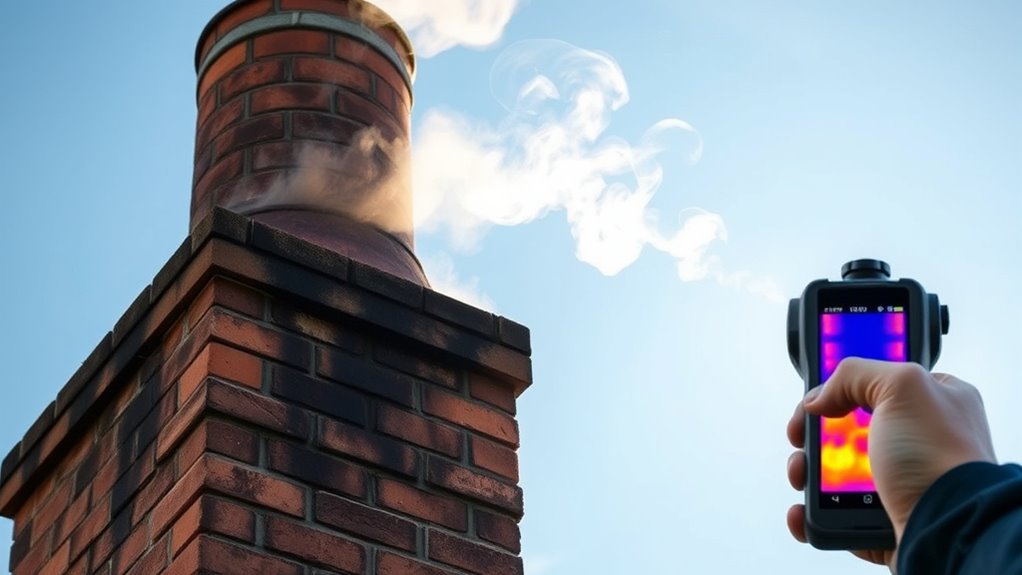
If you’ve identified draft problems in your chimney, there are straightforward fixes you can try before calling in a professional. First, check the chimney design; sometimes, minor adjustments like adding a chimney cap or ensuring a proper height can improve airflow. Ensuring the chimney is free of obstructions, such as creosote buildup or debris, also helps maintain ideal draft. You can increase air pressure inside the fireplace by slightly opening a nearby window or door, which encourages better airflow. Additionally, installing a draft guard or using a chimney balloon temporarily can stabilize air pressure and improve draft performance. Regular maintenance and understanding the importance of ventilation can further prevent draft problems and optimize your chimney’s performance, especially when considering factors like chimney height, airflow dynamics, and proper chimney design. Proper air pressure management is essential for efficient draft and safe operation, and being aware of how narcissistic traits may influence interpersonal interactions can help in managing conflicts or misunderstandings related to these issues.
Preventative Measures to Maintain a Strong Draft
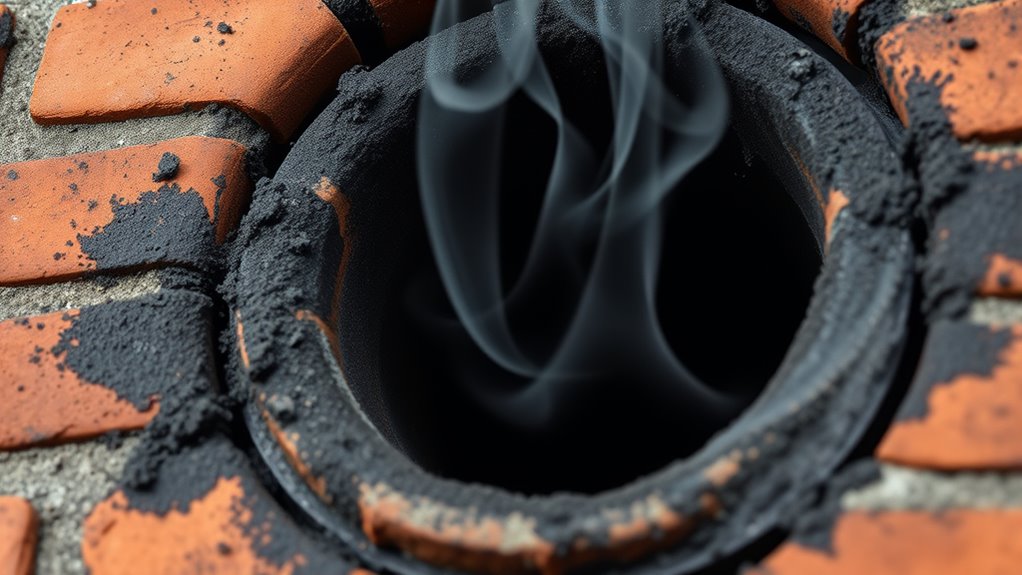
Maintaining a strong chimney draft requires proactive care and regular inspections. To keep your chimney functioning best, prioritize these preventative measures:
- Schedule regular chimney cleaning to remove creosote buildup and debris that can hinder airflow. This process not only improves safety but also ensures optimal soundwave transmission for efficient draft performance.
- Install draft regulators to control airflow and prevent drafts from fluctuating.
- Check for obstructions like bird nests or debris and clear them promptly.
- Staying informed about automation in business can help optimize overall operational efficiency, including maintenance routines.
- Incorporating essential oils for respiratory health into routine maintenance may help improve indoor air quality and support overall chimney health.
- Understanding and utilizing heat pump technology can contribute to more energy-efficient climate control in your home, indirectly supporting overall energy management and sustainability efforts.
When to Seek Professional Help for Chimney Draft Problems
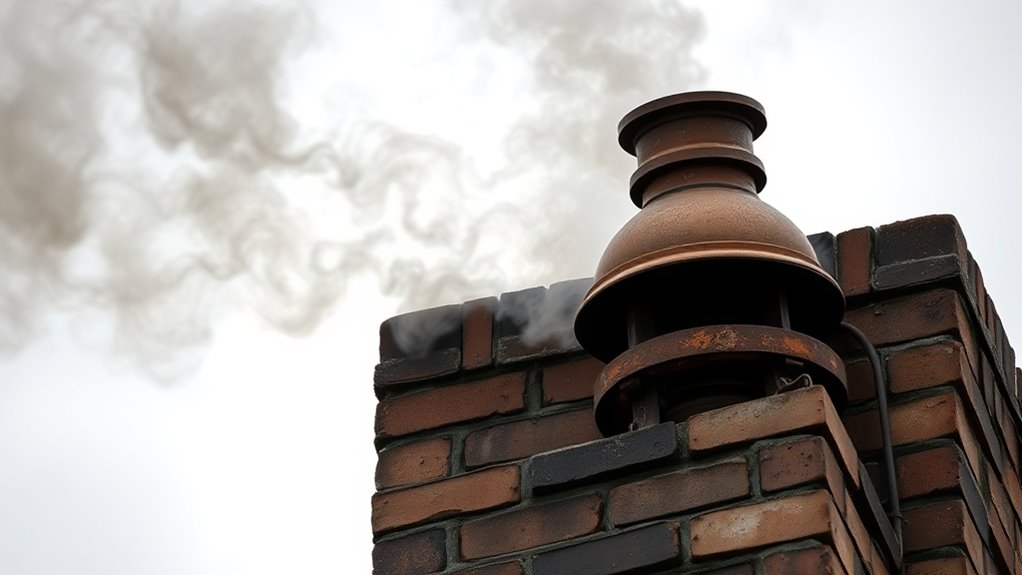
Recognizing when to call in a professional is essential to guaranteeing your chimney functions safely and efficiently. If you notice persistent draft issues despite your efforts, it’s time to seek expert help. Poor draft can lead to dangerous smoke buildup, risking fire safety and carbon monoxide hazards. Additionally, if your chimney shows signs of creosote buildup, cracks, or deterioration, professional chimney maintenance is necessary to prevent potential fires. Regular inspections can identify underlying problems that you might overlook, especially issues related to ventilation and airflow regulation. Don’t ignore stubborn draft problems or unusual odors, as these could indicate blockages or structural damage. Addressing these issues promptly ensures your chimney operates correctly, keeps your home safe, and maintains proper fire safety standards. Proper ventilation and airflow regulation are crucial aspects of effective chimney functioning. When in doubt, consulting a chimney specialist is always the best choice.
Frequently Asked Questions
Can Weather Changes Affect My Chimney’S Draft Efficiency?
Weather impact definitely affects your chimney’s draft efficiency. Climate effects like high winds, cold temperatures, or humidity can disrupt the airflow inside your chimney, making it harder for smoke to escape. When the weather changes, especially during storms or cold snaps, you might notice reduced draft. To keep things running smoothly, consider regular maintenance and check for blockages, ensuring your chimney performs well regardless of the weather impact.
Does Chimney Age Impact Draft Performance Over Time?
Chimney aging can substantially impact your draft performance, leading to draft degradation over time. As your chimney ages, wear and tear, corrosion, and structural shifts can block airflow, reduce efficiency, and cause smoke to back up. Regular inspections and maintenance are essential to address these issues early. Keep an eye on signs of aging, and don’t neglect upkeep—these steps help maintain ideal draft performance and guarantee your chimney functions safely and effectively over the years.
Are There Specific Fuels That Improve or Worsen Draft Issues?
Certain fuels can considerably impact your chimney’s draft performance. Using high-quality fuel, like well-seasoned wood, improves airflow and reduces buildup, making draft issues less likely. Conversely, poor-quality fuel or wet wood can produce more smoke and creosote, worsening draft problems. Choosing the right wood type, such as hardwoods over softwoods, ensures better combustion and airflow, helping your chimney draft stay strong and consistent.
How Does Chimney Height Influence Draft Strength?
Think of your chimney as a mountain peak guiding air flow. When your chimney height increases, the draft strength grows stronger, just like a taller mountain pulls more clouds upward. A taller chimney creates a better chimney draft, improving airflow and combustion. Conversely, a shorter chimney weakens draft strength, causing smoke and gases to linger. So, adjusting chimney height is essential for ideal draft performance and efficient venting.
Can Interior Home Ventilation Interfere With Chimney Draft?
Indoor air quality and ventilation effectiveness can definitely interfere with your chimney draft. When your home has poor or overly aggressive ventilation, it disrupts the airflow needed for proper draft. This can cause smoke or gases to linger inside instead of venting outside efficiently. To maintain a healthy and effective chimney draft, you should balance your indoor ventilation, ensuring it doesn’t negatively impact the airflow that keeps your chimney functioning properly.
Conclusion
A strong chimney draft is essential for safe, efficient fireplace operation. Did you know that improperly maintained chimneys can reduce draft efficiency by up to 50%? Regular inspections, prompt repairs, and proper ventilation help keep your chimney functioning ideally. Addressing draft issues early not only boosts performance but also prevents dangerous buildup of smoke and gases. Stay vigilant and seek professional help when needed—your home’s safety and comfort depend on a reliable chimney draft.
